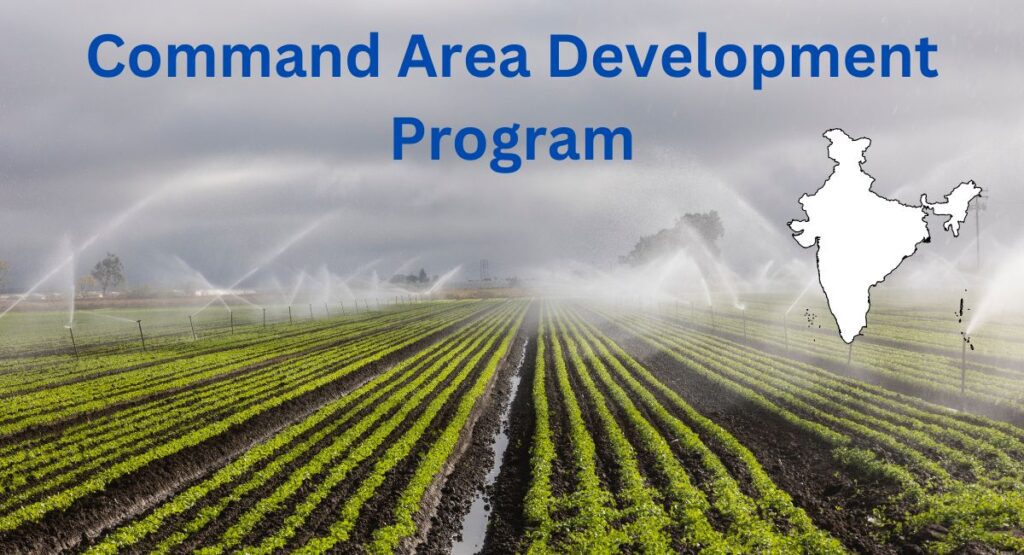In order to bridge the gap between the “Irrigation Potential Available” and “Actual Utilization of theses Resources”, the government of India launched the initiative called Command Area Development Programme (CAD) in the year 1974 with the funding from World Bank. With agriculture being a critical sector for the country’s economy and the majority of the population depending on it for their livelihoods, CAD is a critical initiative for ensuring sustainable agricultural development.

Table of Contents
What is Command Area Development?
Command Area Development is a programme that aims to develop and improve the irrigation infrastructure in irrigated areas to increase agricultural productivity and improve the livelihoods of farmers. The programme also aims to provide farmers with access to credit, technical assistance, and other support services to help them improve their farming practices.
Objectives of Command Area Development
Programme
The objectives of Command Area Development are to increase agricultural productivity, improve the livelihoods of farmers, promote sustainable agriculture, and improve the overall economic development of rural areas. It contains sub-schemes like development of ground water to augment the surface irrigation potential, change in cropping pattern, modernization of irrigation infrastructure, construction of field channel etc.
Implementation of Command Area Development
Programme
The implementation of Command Area Development involves the development of irrigation infrastructure, such as canals, water storage structures, and pump sets. It also involves the provision of technical assistance and support services to farmers, such as training on improved farming practices, access to credit, and the provision of improved seeds, fertilizers, and other inputs.
The scheme is implemented by the Ministry of Water Resources, River Development and Ganga Rejuvenation, Government of India.
Achievements of Command Area Development Programme
Command Area Development has had several achievements, including the improvement of irrigation infrastructure, the increase in agricultural productivity, and the improvement of the livelihoods of farmers. The programme has also helped to improve access to credit and other support services, which has enabled farmers to improve their farming practices and increase their incomes.
Challenges and Criticisms
The Command Area Development Programme faces several challenges and criticisms, including the lack of adequate financial resources, inadequate technical capacity, and the lack of participation by local communities. These challenges highlight the need for continued innovation, capacity building, and support to ensure the success of this initiative.
Current Status of the Programme
The programme is now implemented under the name “Pradhan Mantri Krishi Sinchai Yojana”. Pradhan Mantri Krishi Sinchai Yojana (PMKSY) is a flagship programme of the Government of India launched in 2015. It aims to enhance the adoption of precision irrigation and other water-saving technologies, and improve water use efficiency in the agriculture sector.
The scheme has the following objectives:
- To provide a permanent solution to the problems of drought and scarcity of water in agriculture.
- To enhance the coverage of irrigation in the country.
- To improve water use efficiency by adopting modern irrigation technologies.
- To promote sustainable water conservation practices.
- To create a platform for convergence of investments in irrigation.
- To ensure the participation of farmers in irrigation management.
The PMKSY has three components:
- Accelerated Irrigation Benefit Programme (AIBP): This component aims to accelerate the implementation of ongoing major and medium irrigation projects, including repair, renovation, and restoration of water bodies.
- Har Khet Ko Pani (HKKP): This component aims to enhance the coverage of irrigation by promoting precision irrigation technologies like drip and sprinkler irrigation, and encouraging the construction of small water storage structures.
- Per Drop More Crop (PDMC): This component aims to improve water use efficiency in agriculture by promoting efficient water management practices, such as micro-irrigation, and providing financial assistance to farmers to adopt these technologies.
The PMKSY is implemented by the Ministry of Jal Shakti, Government of India, in partnership with state governments. The scheme has been successful in increasing the coverage of irrigation in the country and promoting sustainable water management practices in agriculture. It has also contributed to the socio-economic development of rural areas by enhancing agricultural productivity and income of farmers.
Conclusion
Command Area Development is a critical initiative for improving agricultural productivity and livelihoods in irrigated areas in India. With its comprehensive approach and multi-faceted components, this programme has the potential to bring about significant positive changes in the lives of farmers and the overall development of rural areas. By continuing to focus on Command Area Development, India can promote sustainable agriculture and improve the lives of its rural people.